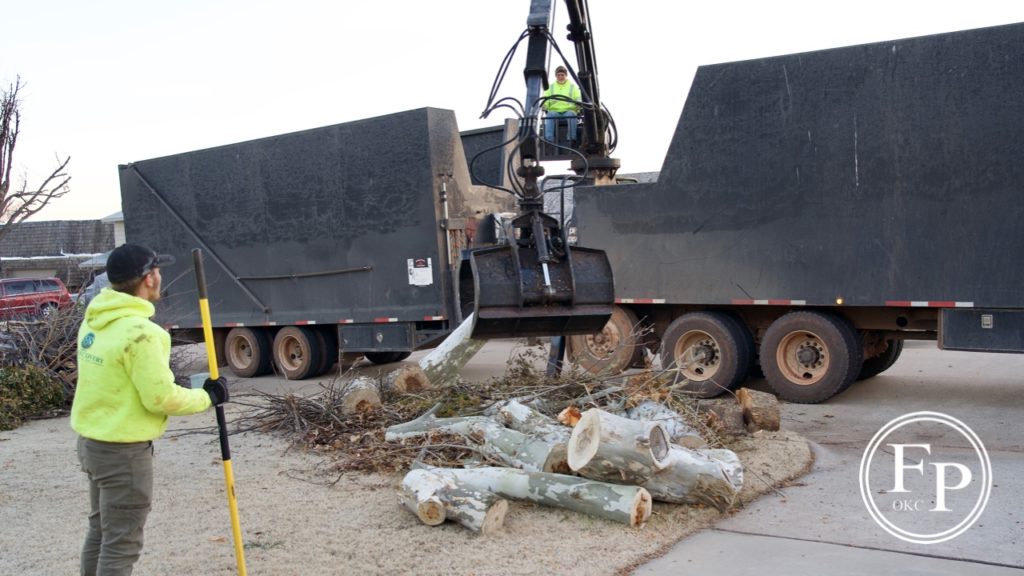Last Updated on January 28, 2021, 8:45 AM | Published: January 28, 2021
Oklahoma City announced Monday that the final pass for storm debris removal will begin February 1. The City urges all residents whose storm debris has not been picked up to move their limbs to the curb for pickup by that date.
The ice storm of October 26 lasted two days, and left thousands of Oklahoma City residents without electricity, some for well over a week. The early storm came before most trees lost their foliage, resulting in much heavier burdens from the accumulated ice. All 621 square miles of Oklahoma City were affected by the storm.
In advance of the second pass starting February 1, residents should be aware that limbs piled under or near obstructions will not have their limbs picked up. Limbs must not be piled under trees or near mailboxes, fire hydrants, or vehicles. Limbs under trees will need to be moved to allow crews to retrieve them.
First Pass
Free Press spoke by phone with Utilities Department spokesperson Jennifer McClintock. According to McClintock, debris from the storm was originally anticipated to be over 100,000 tons (or 2 million pounds). Now that the city is nearing the end of the first pass of collecting debris, they have already picked up approximately that amount.
During the process of planning for the debris removal, the estimates were made by driving through neighborhoods and basing projections on what debris was visible. However may residents had debris along the curb, as well as in backyards and side yards where the debris wasn’t visible from the street.
The second pass, McClintock said, gives residents the opportunity to move extra debris from behind or beside their homes to the curbline where crews can pick it up.
Clean up efforts have been ongoing since the storm, and the first pass for residential debris collection is expected to wrap up by January 30.
Resident Readiness
The City requests residents to cut limbs to a length of 10 feet or shorter, and to keep other non-tree debris and bulky trash separate from storm debris.
The second pass will begin on February 1 along Western Avenue, and will move east and west from there. Officials predict the second pass to complete by March 6. Any residents with remaining tree and limb debris after the second pass may place their debris for bulky trash pick-up, following the city’s guidelines.
Residents can see a map to follow the progress of debris crews on the City’s website at okc.gov/debrismap.
Unusual storm
McClintock told Free Press that how early in the year the storm hit created the additional challenge of trees still having foliage, which created more damage across the city. The foliage caught more ice which created more weight on the limbs. While the City is no stranger to storm events and the clean-up that is required afterward, McClintock pointed out that a storm like this is very different from a wind event.
Straight-line winds and tornadoes tend to affect only parts of the City, whereas this storm hit the entire 621 square mile area that makes up Oklahoma City. That made clean-up a much larger job than most the city has faced in the past.
“We hire in contractors who are approved by FEMA and who are specialists.Getting enough trucks on the ground at the beginning was hard because a lot of the contractors were responding to hurricanes in Louisiana and elsewhere at the time,” McClintock explained.
“Since we need to apply to FEMA for reimbursement, we have to follow a certain process. That keeps us from taking a financial loss,” McClintock said, adding that it also keeps the Utilities Department from passing the costs on to the customers.
Debris Destination
Debris collected during both passes will be taken to various landfills around the City. Most of those landfills have been chipping the wood to act as a sort of mulch covering for the landfills. This helps prevent erosion by wind and rain, as well as defeating some of the odor of the landfills.
Space at landfills has not yet been an issue, though McClintock encouraged OKC residents to participate in the City’s recycling program. Recycling keeps more solid waste from taking up space in landfills.
Columnist covering local government in Oklahoma City and Oklahoma County from May 2019 through June 2023.










